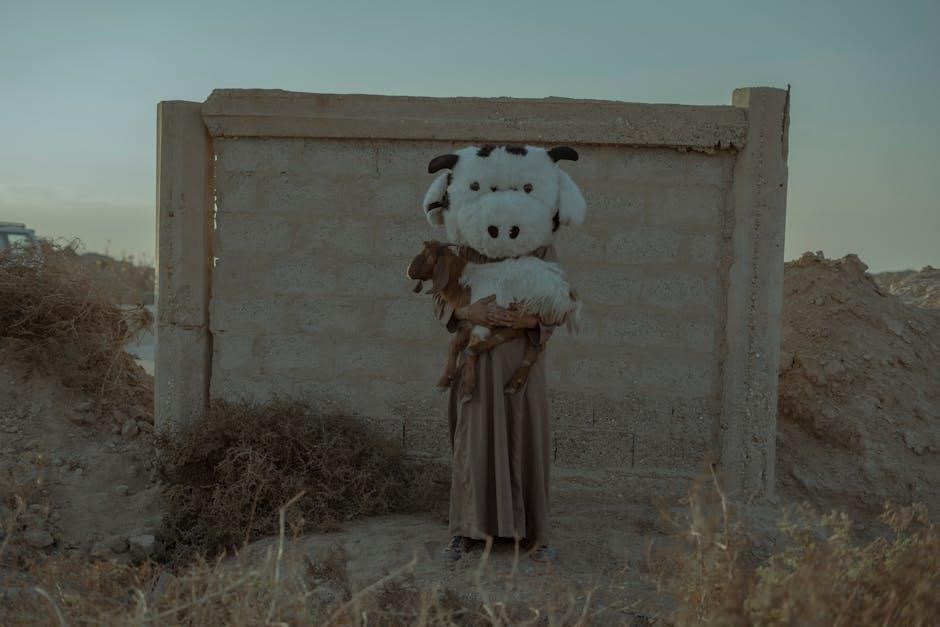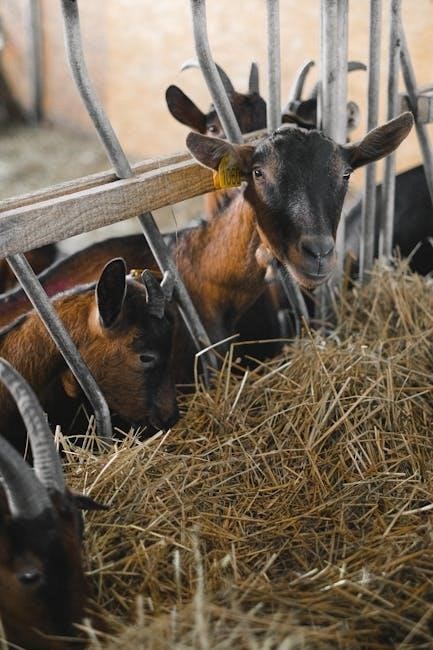Edward Albee’s The Goat‚ or Who Is Sylvia? is a provocative play written in 2000‚ exploring themes of love‚ betrayal‚ and societal taboos through Martin’s confession of loving a goat named Sylvia‚ sparking familial and moral chaos‚ and earning the 2002 Tony and Drama Desk Awards for Best Play.
1.1 Overview of the Play
Edward Albee’s The Goat‚ or Who Is Sylvia? is a two-act play that revolves around Martin‚ a successful architect‚ whose life unravels when he confesses to his wife‚ Stevie‚ and their gay teenage son‚ Billy‚ that he has fallen in love with a goat named Sylvia. The play explores themes of love‚ betrayal‚ and societal taboos‚ blending dark humor with profound existential questions. Albee’s provocative narrative challenges conventional norms‚ leading to a tragic confrontation that shatters the family’s equilibrium and raises questions about morality‚ judgment‚ and the true nature of love.
1.2 Historical Context and Background

The Goat‚ or Who Is Sylvia? was written by Edward Albee in 2000 and premiered on Broadway in 2002‚ marking a significant return to form for the playwright. The play’s controversial themes of bestiality and marital betrayal sparked intense reactions‚ drawing both criticism and acclaim. Set against the backdrop of early 2000s societal norms‚ the play critiques conventional morality and explores existential questions. Albee’s work aligns with the Absurdist Theatre tradition‚ challenging audiences to confront uncomfortable truths about love‚ identity‚ and judgment in a seemingly rational world.
1.3 Edward Albee’s Style and Themes
Edward Albee’s style in The Goat‚ or Who Is Sylvia? blends absurdism with dark humor‚ creating a tense‚ emotionally charged narrative. His themes often explore societal taboos‚ marital dysfunction‚ and existential crises. The play delves into the complexities of love‚ identity‚ and moral judgment‚ challenging audiences to confront uncomfortable truths. Albee’s work critiques conventional norms‚ using Sylvia as a metaphor for hidden desires and societal hypocrisy‚ reflecting his signature exploration of human frailty and the absurdity of rationality in an irrational world.
Literary Context and Significance
The Goat‚ or Who Is Sylvia? is a landmark in absurdist theatre‚ winning the 2002 Tony and Drama Desk Awards. It challenges societal norms‚ exploring taboo themes like unconventional love and moral ambiguity‚ solidifying its place in modern drama.
2.1 The Play’s Place in Absurdist Theatre
The Goat‚ or Who Is Sylvia? firmly situates itself within the absurdist theatre tradition‚ leveraging illogical scenarios and moral ambiguity to provoke thought. By exploring forbidden love and societal taboos‚ Albee challenges conventional norms‚ aligning with the absurdism movement’s focus on the irrational. The play’s controversial themes and its 2002 Tony and Drama Desk Awards highlight its significance in modern drama‚ showcasing how absurdity can reflect deeper truths about human nature and societal constraints. Its emotional and intellectual impact underscores its enduring relevance in literary discourse.
2.2 Themes of Love‚ Betrayal‚ and Identity
The Goat‚ or Who Is Sylvia? explores themes of love‚ betrayal‚ and identity through Martin’s illicit relationship with Sylvia‚ a goat. This taboo love challenges societal norms‚ forcing characters to confront their true selves. Betrayal emerges as Martin’s confession shatters his family’s trust‚ while identity is questioned through the characters’ moral dilemmas. The play delves into the complexities of love beyond societal boundaries‚ raising profound questions about morality‚ judgment‚ and the human condition‚ ultimately highlighting the destructive power of unchecked desires and the fragility of familial bonds.
2.3 Societal Taboos and Controversies
The Goat‚ or Who Is Sylvia? tackles societal taboos head-on‚ particularly through Martin’s relationship with a goat‚ Sylvia‚ which shocks audiences and challenges moral norms. The play sparks controversy by exploring bestiality‚ a deeply forbidden act‚ forcing viewers to confront their own judgments about love and acceptance. Albee’s bold portrayal of such a taboo subject has led to widespread debate‚ questioning the boundaries of art and morality. Despite the controversy‚ the play won major awards‚ including the 2002 Tony Award for Best Play‚ highlighting its impact on modern theatre and its ability to provoke necessary conversations about societal norms and acceptance.

Key Themes and Motifs
The play explores themes of taboo love‚ authenticity‚ and moral judgment‚ using Sylvia as a symbol of forbidden desire and societal condemnation‚ challenging conventional norms.
3.1 The Intersection of Love and Taboo
Albee masterfully intertwines love and taboo through Martin’s relationship with Sylvia‚ a goat‚ challenging societal norms and exploring the boundaries of acceptable affection. This unconventional love story provokes deep reflections on moral judgment and the consequences of transgressing societal expectations. The play uses Sylvia as a metaphor for forbidden desire‚ highlighting the tension between genuine emotional connections and the constraints imposed by cultural norms. By blurring the lines between human and animal‚ Albee forces the audience to confront their own biases and the nature of love itself.
3.2 The Quest for Authenticity in Relationships
The play delves into the universal human desire for authentic connections‚ as Martin’s relationship with Sylvia symbolizes his longing for genuine emotional engagement. His marriage to Stevie‚ though seemingly stable‚ lacks the depth he craves‚ leading him to seek solace in a taboo connection; Albee explores how societal expectations often suffocate true intimacy‚ forcing individuals into superficial relationships. Through Martin’s plight‚ the play questions the authenticity of human bonds and the sacrifices made to maintain them‚ highlighting the tension between societal norms and personal truths.
3.3 The Role of Judgment and Morality

The play critiques societal judgment and morality through Martin’s taboo relationship with Sylvia‚ challenging conventional norms. Albee portrays judgment as a destructive force‚ highlighting how moral expectations can shatter relationships and lives. The characters’ reactions to Martin’s confession reveal the hypocrisy and rigidity of societal morality‚ emphasizing the clash between personal truths and collective ethical standards. This exploration questions the validity of moral frameworks in a world where love and identity are often policed‚ leaving audiences to ponder the ethical implications of their own judgments.
Character Analysis
The play delves into the complexities of Martin‚ Stevie‚ Billy‚ and Sylvia‚ exploring their identities‚ relationships‚ and moral dilemmas‚ revealing deep emotional struggles and societal conflicts.
4;1 Martin: The Complex Protagonist
Martin is a multifaceted character whose confession of loving Sylvia‚ a goat‚ unleashes chaos. His struggle between societal expectations and personal truth highlights his quest for authenticity and the fragility of human relationships. Through his journey‚ Albee examines themes of morality‚ judgment‚ and the absurdity of societal norms‚ making Martin a deeply relatable yet controversial figure in the play.
4.2 Stevie: The Wife and Her Struggles
Stevie‚ Martin’s wife‚ embodies the emotional turmoil and confusion sparked by her husband’s shocking confession. Her reaction to Martin’s revelation—pausing‚ smiling‚ and giggling before exiting—reflects her struggle to comprehend the absurdity of the situation. Stevie’s character represents the societal expectation of marital fidelity and the moral judgment that follows its breach. Her journey from disbelief to potential anger or sadness highlights the human cost of Martin’s actions and the deeper exploration of love‚ betrayal‚ and identity in the play. Stevie’s struggles serve as a mirror to the audience’s own moral dilemmas and societal conditioning.
4.3 Billy: The Gay Teenage Son
Billy‚ the gay teenage son of Martin and Stevie‚ represents another layer of familial complexity and societal judgment. His character underscores the play’s exploration of identity and acceptance‚ particularly in the context of his father’s scandalous affair with Sylvia. Billy’s sexual orientation adds depth to the family’s dynamics‚ as it challenges traditional norms and provokes further tension. His presence in the play serves as a reminder of the broader societal taboos and the struggle for authenticity in relationships‚ making him a pivotal figure in the unfolding drama.
4.4 Sylvia: The Symbolic Goat
Sylvia‚ the goat‚ serves as a powerful symbol in the play‚ representing Martin’s longing for authenticity and connection. Her presence challenges societal norms and moral judgment‚ embodying themes of forbidden love and existential yearning. Sylvia is not merely a character but a metaphor for the primal and instinctual aspects of human nature‚ forcing the audience to confront uncomfortable truths about desire and relationships. Her role transcends literal interpretation‚ becoming a catalyst for the familial and moral chaos that ensues.
Plot Summary and Structure
The play revolves around Martin’s shocking confession of loving a goat named Sylvia‚ unraveling his family dynamics and exploring themes of love‚ betrayal‚ and societal judgment.

Act 1 introduces Martin‚ a successful architect‚ his wife Stevie‚ and their gay teenage son Billy‚ presenting a seemingly perfect family. Martin confesses to his friend Ross that he has fallen in love with a goat named Sylvia‚ shocking Stevie and igniting familial tension. Stevie’s disbelief and Martin’s justification of his feelings set the stage for the play’s exploration of taboo love and moral judgment. The act establishes the central conflict‚ blending humor with profound emotional depth‚ as the family’s dynamics unravel.
5.2 Act 2: The Climax and Falling Action
Act 2 escalates the emotional turmoil as Martin’s confession about Sylvia deepens the family’s crisis. Stevie‚ devastated by her husband’s revelation‚ confronts him‚ leading to a heated argument that exposes the fragility of their marriage. Martin attempts to justify his feelings‚ sparking a philosophical debate about love and societal norms. Meanwhile‚ their son Billy struggles with his own identity‚ adding layers to the familial tension. The act reaches its climax as Stevie’s anger boils over‚ culminating in a dramatic confrontation that reshapes the family’s dynamics and sets the stage for the play’s resolution.
5.3 The Resolution and Its Implications
The resolution of The Goat‚ or Who Is Sylvia? leaves a lingering sense of tragedy and moral ambiguity. Martin’s relationship with Sylvia ultimately destroys his family‚ as Stevie and Billy grapple with the fallout. The play concludes with a haunting reflection on societal norms and the consequences of unconventional love. Albee challenges the audience to question their judgments about relationships and morality‚ leaving a profound impact on the viewer. The final act underscores the play’s themes of existential crisis and the enduring struggle for authenticity in a judgmental world.

Critical Reception and Awards
The Goat‚ or Who Is Sylvia? received widespread acclaim‚ winning the 2002 Tony Award for Best Play and the Drama Desk Award for Outstanding Play‚ solidifying its impact on modern theatre and sparking debates on taboo subjects.
6.1 Tony Award for Best Play (2002)
The play won the prestigious Tony Award for Best Play in 2002‚ recognizing its bold exploration of taboo themes and its impact on contemporary theatre. This honor highlighted Edward Albee’s ability to provoke thought and challenge societal norms‚ cementing the play’s place in theatrical history.
6.2 Drama Desk Award for Outstanding Play (2002)
In 2002‚ the play received the Drama Desk Award for Outstanding Play‚ further solidifying its critical acclaim. This award acknowledged the play’s innovative storytelling and its fearless confrontation of taboo subjects‚ reinforcing its influence on modern theatre and its ability to provoke meaningful dialogue among audiences and critics alike.
6.3 Reviews and Critical Analysis
The Goat‚ or Who Is Sylvia? received widespread critical acclaim for its bold exploration of taboo themes and existential questions. Critics praised Albee’s ability to blend dark humor with profound introspection‚ challenging societal norms and moral judgments. The play’s controversial premise sparked intense debates‚ with many hailing it as a masterpiece of modern theatre. Reviewers noted its thought-provoking narrative and the depth of its characters‚ particularly Martin’s struggle with societal expectations and personal authenticity. The play’s success was further validated by its Tony and Drama Desk Awards‚ solidifying its place in theatrical history.

Cultural Impact and Legacy
Edward Albee’s The Goat‚ or Who Is Sylvia? has significantly influenced modern theatre‚ sparked discussions on taboo subjects‚ and inspired numerous adaptations‚ leaving a lasting cultural legacy.
7.1 Influence on Modern Theatre
The Goat‚ or Who Is Sylvia? has left an indelible mark on modern theatre‚ challenging norms and inspiring playwrights to explore controversial themes. Its bold narrative‚ which delves into societal taboos and moral ambiguity‚ has influenced contemporary storytelling‚ encouraging writers to push boundaries. The play’s success‚ including its Tony and Drama Desk Awards‚ has solidified its place as a landmark work‚ provoking discussions on censorship and artistic freedom. Its impact continues to resonate‚ inspiring new voices to tackle unconventional subjects with unflinching honesty.

7.2 Discussions on Taboo Subjects in Media
The Goat‚ or Who Is Sylvia? sparked intense debates about media’s role in addressing taboo subjects. The play’s exploration of forbidden love and societal judgment challenged traditional narratives‚ encouraging broader conversations about censorship and artistic freedom. Its success demonstrated audiences’ willingness to engage with controversial themes‚ inspiring media creators to tackle similar topics with authenticity. This shift has led to more diverse storytelling in film‚ theatre‚ and literature‚ fostering a culture where once-taboo subjects are openly discussed and explored.

7.3 Adaptations and Performances
The Goat‚ or Who Is Sylvia? has been widely performed since its Broadway debut in 2002. Notable productions include its premiere at the Golden Theatre‚ New York City‚ and subsequent runs in regional theaters worldwide. The play’s provocative nature has attracted diverse audiences‚ with its PDF script readily available online‚ facilitating widespread performances. Its enduring appeal lies in its ability to spark dialogue‚ making it a staple in both professional and academic theatre settings‚ ensuring its continued relevance and impact on contemporary audiences.
The Goat‚ or Who Is Sylvia? remains a thought-provoking play‚ challenging societal norms and sparking moral debates. Its PDF availability ensures continued relevance in contemporary theatre discussions.

8.1 Final Thoughts on the Play’s Relevance
Edward Albee’s The Goat‚ or Who Is Sylvia? continues to resonate with audiences due to its exploration of taboo themes and moral dilemmas. The play’s ability to provoke discomfort and introspection ensures its relevance in modern theatre. Its unflinching examination of love‚ betrayal‚ and societal expectations challenges viewers to confront their own judgments. As a PDF‚ the script remains accessible‚ allowing new generations to engage with its profound and unsettling questions about human nature and the boundaries of love.
8.2 The Enduring Questions Raised by the Play
The Goat‚ or Who Is Sylvia? poses enduring questions about love‚ morality‚ and identity. It challenges audiences to question societal norms and the true meaning of betrayal. The play’s exploration of unconventional relationships forces viewers to confront their own biases and moral frameworks. As a PDF resource‚ the script continues to prompt discussions on authenticity and the limits of human understanding‚ ensuring its relevance in both academic and theatrical contexts.